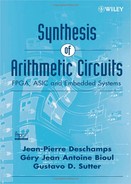PREFACE
From the beginnings of digital electronic science, the synthesis of circuits carrying out arithmetic operations has been a central topic. As a matter of fact, it is an activity directly related to computer development. From then on, a well-known technical discipline was born: computer arithmetic. Traditionally, the study of arithmetic circuits has been oriented toward applications to general-purpose computers, which provide the most important applications of digital circuits. However, the electronic market share corresponding to specific systems (embedded systems) is significant. It is important to point out that the huge business volume that corresponds to general-purpose computers (personal computers, servers, main frames) is distributed among a relatively reduced number of different models. Therefore the number of designers involved in general-purpose computer development is not as big as it might seem and is much less than the number of engineers dedicated to production and sales. The case of embedded systems is different. Embedded systems are circuits designed for specific applications (special-purpose devices), so a great diversity of products exist in the market, and the design effort per fabricated unit can be a lot bigger than in the case of general-purpose computers. In consequence, the design of specific computers is an activity in which numerous engineers are involved, in all type of companies—even small ones—within numerous countries.
In this book methods and examples for synthesis of arithmetic circuits are described with an emphasis somewhat different from the classic texts on computer arithmetic.
- It is not limited to the description of the arithmetic units of computers.
- Descriptions of computation algorithms are presented in a section apart from the one dedicated to their materialization or implementation by digital circuits. The development of an embedded system is an operation of hardware–software codesign for which it is not known beforehand what tasks will be executed by a microprocessor and what other tasks by specific coprocessors. For this reason, it appeared useful to describe the algorithms in an independent manner, without any assumption on subsequent executions by an existent processor (software) or by a new customized circuit (hardware).
- A special, although not exclusive, importance has been given to user programmable devices (field programmable devices such as FPGAs), especially to the families Spartan II and Virtex. Those devices are very commonly used for the realization of specific systems, mainly in the case of small series and prototypes. The particular architecture of those components leads the designer to use synthesis techniques somewhat different from the ones applied for ASICs (application-specific integrated circuits) for which standard cell libraries exist.
- In what concern circuits description, logic schemes are presented, sometimes with some VHDL models, in such a way that the corresponding circuits can easily be simulated and synthesized.
After an introductory chapter, the book is divided in two parts. The first one is dedicated to mathematical aspects and algorithms: mathematical background (Chapter 2), number representation (Chapter 3), addition and subtraction (Chapter 4), multiplication (Chapter 5), division (Chapter 6), other arithmetic operations (Chapter 7), and operations in finite fields (Chapter 8). The second part is dedicated to the central topic—the synthesis of arithmetic circuits: hardware platforms (Chapter 9), general principles of synthesis (Chapter 10), adders and subtractors (Chapter 11), multipliers (Chapter 12), dividers (Chapter 13), other arithmetic primitives (Chapter 14), operators for finite fields (Chapter 15), and floating-point unit.
Numerous VHDL models, and other source files, can be downloaded from http://www.ii.uam.es/~gsutter/arithmetic/. This will be indicated in the text (e.g., complete VHDL source code available). As regards the VHDL models, they are of two types: some of them have been developed for simulation purposes only, so the working of the corresponding circuit can be observed; others are synthesizable models that have been implemented within commercial programmable components (FPGA's).
The authors thank the people who have helped them in developing this book, especially Dr. Tim Bratten, for correcting the text, and Paula Mirón, for the cover design. They are grateful to the following universities for providing them the means for carrying this work through to a successful conclusion: University Rovira i Virgili (Tarragona, Spain), University Rey Juan Carlos (Madrid, Spain), State University UNCPBA (Tandil, Argentina), University FASTA (Mar del Plata, Argentina), and Autonomous University of Madrid (Spain).
JEAN-PIERRE DESCHAMPS
University Rovira i Virgili
GÉRY JEAN ANTOINE BIOUL
National University of the Center of the Province of Buenos Aires
GUSTAVO D. SUTTER
University Autonoma of Madrid
